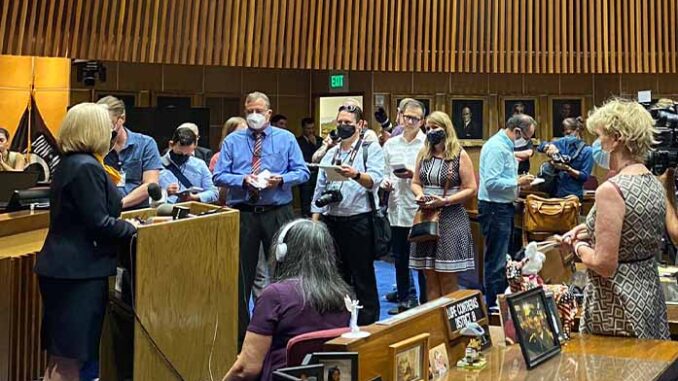
An expert in engineering systems and pattern recognition software who holds a PhD from Massachusetts Institute of Technology reported during last Friday’s Senate Audit presentation that nearly 4,500 ballots may have been counted in Maricopa County’s 2020 General Election even though the voters’ signatures were missing as required by law.
Dr. Shiva Ayyadurai of EchoMail Inc. was contracted by Senate President Karen Fann to review images of the more than 1.9 million “affidavit” return envelopes which held the early ballots mailed in or dropped off at Maricopa County voting centers between Oct. 7 and Nov. 3.
Each return envelope contains a signature box, which under Arizona law must be signed by the voter and matched by the Recorder’s Office to the voter’s registration file. There is also a signature “area” on the Braille ballots, large-print ballots, and three styles of online voting via the Uniformed and Overseas Citizens Absentee Voting Act (UOCAVA) utilized in Maricopa County.
Ayyadurai’s review, however, did not look at the specific signatures.
Instead, he focused on whether the signature area contained a signature or anything that could reasonably be considered a signature. And what he found is included in Fann’s letter asking Arizona Attorney General Mark Brnovich to consider further investigation to ensure adherence with state law.
“The signature verification process for absentee ballots is imperfect and requires improvement and additional testing,” Fann wrote to the attorney general. “Signatures on mail-in ballots should not be accepted unless they closely match the voters’ authenticated signatures that are on file.”
The problem, according to Ayyadurai’s review, is that Maricopa County provided the Senate with images for 1,911,918 unique return envelopes or other forms of ballot signatures. Of those, 99.77 percent were found by Ayyadurai’s program to contain what he categorized as a signature.
But the review found 1,919 signature areas he suggests should not have been stamped “Verified & Approved MCTEC” because there was only a small stray mark in the area or the area was completely blank. By comparison, Maricopa County reported rejecting only 1,455 ballots due to no signature.
In addition, Ayyadurai’s review found another 2,580 signature areas contained a non-white pixel density of between 0.1% to 1%. These were described as scribbles that were likely a larger stray mark or an illegible signature and thus those ballots likely should not have been counted.
Ayyadurai also told Fann is review suggests more than one ballot may have been tabulated for 17,126 voters based on the number of duplicate return envelope images provided by Maricopa County.
According to Ayyadurai’s report, a total of 17,322 extra return envelopes images are tied to the 17,126 voters. That means some of those voters had two, three, and even four envelope images on file.
Those duplicate images were not included by Ayyadurai during his review of the signature areas. In the end, that review found only 1,907,419 envelopes should have moved on to an actual signature verification step. By comparison, Maricopa County reported 1,915,487 signatures passed verification and those ballots went to tabulation.
There could be a simple reason why Maricopa County had more than one image of a return envelope for those voters, but unfortunately Maricopa County refused to participate in the Senate’s audit.
Ayyadurai ended his report by telling Fann it “is absolutely necessary” for someone to undertake a full review of Maricopa County’s signature verification process to see if it followed state law and Arizona’s election procedures manual.
Based on Fann’s referral to the attorney general, such a review could be undertaken by the AG’s election integrity unit.
